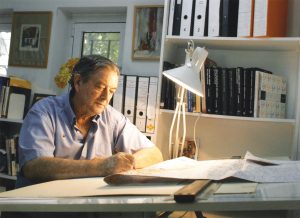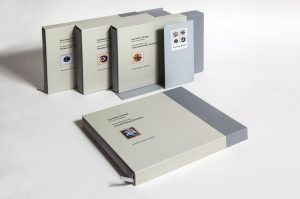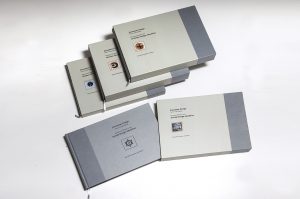Jerusalem Design
God is in the Details *
Jerusalem is unlike any other city in the world, in that many design patterns, of diverse national, religious and ethnic cultures, blend harmoniously in a cosmopolitan melting pot.
* The theme of the Jerusalem Design Guide, “God is in the Details,” derives from an idiom attributed to architect Mies Van Der Rohe, which implies that the quality of any product depends, ultimately, on the perfection of its details.
Preface
This website is based on an exclusive four-volume publication under the title “Jerusalem Design – God is in the Details – Multicultural Design Identities”. Each volume in the set is dedicated to one of Jerusalem’s major design identities: Jewish Design Identities (303 pages with app. 700 illustrations), Christian Design Identities (395 pages with app. 1,000 illustrations), Muslim Design Identities (537 pages with app. 1,300 illustrations) and Modern 20th Century Design Identities (226 pages with app. 500 illustrations). The complete set was published as a private publication limited to only 50 copies. Each volume is autographed by the author.
For more information please contact us.
This publication is the source of inspiration for an exhibition to be held at the Israel Museum in the Fall of 2017.
An abridged 520 page edition of the four volume set will be published in Hebrew by Keter Publishing House in the spring of 2017.
Purpose & Contents. The Jerusalem Multicultural Design Guide highlights the fact that no other city in the world has such a cosmopolitan variety of building styles and design features. Different nationalities, cultures, religious and ethnic groups have built Jerusalem for generations, and their design identities are engraved on the city’s stone walls. The grammar of Jerusalem’s rich visual language is composed of numerous details. Just as sentences are made up of words, so the city’s built heritage is composed of its functional, structural and ornamental details, as well as its religious traditions and ways of life.
The Multicultural Design Guide encompasses over hundreds of entries, with over 3,000 illustrations. Three sections are dedicated to ethnic-religious design identities – one to Jewish Design Identities, one to Christian Design Identities and one to Muslim Design Identities. The fourth section relates to 20th Century Modern Design Identities.
The illustrated Guide draws on Jerusalem’s contemporary, multicultural mundane scene, which is a living museum, one whose detailed contents are familiar only to few. Many of the city’s unique design components are anonymous, but deserving of be discovered, exposed, elaborated and explained. The Guide thus directs the untrained eye to look, understand and appreciate the many interesting details which hide in Jerusalem’s day-to-day urban chaos. The more one notices and appreciates the numerous features in the city’s fabric, the more Jerusalem’s unique character and beauty becomes apparent.
Jerusalem’s design vocabulary consists of two basic components. One facet is its functional and ornamental features; the other, design motifs that symbolize religious beliefs, ethnic traditions and changing trends of design and lifestyles. The motto “God is in the Details” derives from an idiom attributed to architect Mies Van Der Rohe, which implies that the quality and beauty of any type of product depends, ultimately, on the perfection of its details.
Structure and Framework. The Guide is structured to give visual coherence to the jumble of features in Jerusalem’s townscape, and groups them into specific definable categories. The first three sections each contain one major religious and ethnic design identity: Jewish, Christian, and Muslim, which were most discernable in Jerusalem until the early 1920s. Subsequently, ethnic-religious design characteristics became less apparent and gradually diminished. The 20th century, which is presented in the fourth section, was characterized by the emergence of modern trends, including Art-Nouveau, Art-Deco and Bauhaus designs in the first half of the 20th century, and the International Style, Neo-Orientalism and the Brutalist Style, in the second half.
Historic Periods. The Guide presents the most typical and significant elements, features and motifs in Jerusalem’s urban scene, as it exists today, both in the Old and the New City, but does not include historic remnants found in archaeological excavations. The Guide spans some 700 years of Jerusalem’s built heritage, from the Mamluk period (1260-1517) on, through the Ottoman period (1517-1917), the British Mandate (1917-1948), and from the establishment of the State of Israel in 1948, until the end of the 20th century. The Guide also relates to a number of design details in prominent earlier landmarks, like the Dome of the Rock, the Holy Sepulcher and the al-Aqsa Mosque. Included also are significant features and motifs from buildings which were demolished, mostly since the late 1960s, and some decorative design elements which were removed from buildings which still exist.
Research and Choice. The Guide’s visual and verbal presentation is based on over four decades of research into Jerusalem’s built heritage by David Kroyanker, his various publications, as well as the historic urban architectural archive which he has built up, over the years; it is believed that it is one of the largest of its kind in the world. The Guide is also based on academic publications relating to Jerusalem’s history and development.
Jerusalem’s complex urban texture includes thousands of buildings located in neighborhoods, quarters, streets, alleys and courtyards, all over the city. From this almost limitless spectrum were chosen the most significant typical examples for each category. At times, certain buildings or motifs are presented within different contexts, in more than one religious-ethnic identity or design category.
Graphic Presentation. The graphic presentation of the illustrated Guide combines photographs and line drawings, which enabled Kroyanker to bring “back to life” the original look and quality of buildings and/or design features, which were neglected, had deteriorated, or were covered by various additions. Most of the photographs are his own; others are by photographers whose names are credited. The majority of line drawings are based on his photographs; they were drawn by architects and students who assisted him, from the early 1970s on.
It is hoped that this website will contribute to a better and wider knowledge and understanding of Jerusalem’s urban fabric, and will encourage public awareness of the need for conserving and preserving its precious historic built heritage. In a website of this scope, mistakes will inevitably occur. The developers would be grateful for any corrections brought to their attention.


